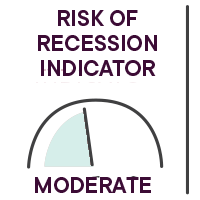Yann Furic
B.B.A., M. Sc., CFA®
Senior Portfolio Manager, Asset Allocation and Alternative Strategies
Sharp rise in interest rates
The month of February was marked by a widespread, sharp rise in long-term interest rates.
This led to a decline in growth stocks, whose value is negatively impacted by an increase in rates.
Equity indices with a significant weighting in more cyclical stocks (industrial products, financial services, basic materials and energy) benefited from the prospect of a strong economic recovery.
Vaccination campaigns are continuing and the addition of new vaccines could help achieve herd immunity faster than expected, particularly in the United States, which should accelerate the economic recovery.
Job creation in the United States was stronger than expected.
Focus on the past month

Overview of global equity markets*
- The flagship index of the Canadian stock market, the S&P/TSX, advanced 4.2% in February.
- In the United States, the S&P 500 gained 2.6% and the Nasdaq, 0.9%.
- International stock markets were also in positive territory during the month, with the EAFE index up 2.1%.
- Emerging market equities rose 1.0% in February, while Chinese stocks climbed 0.7%.
* All the percentages in this section are in Canadian dollars. Bloomberg unless otherwise indicated.
Key events

Employment outlook
Job creation was positive in the United States, with 379,000 jobs created versus expectations of 200,000. The unemployment rate fell from 6.3% to 6.2%.
Targeted impact
Job losses continue to negatively impact the economy. The most affected sectors are those that have been the target of partial lockdown measures triggered by the second wave of COVID-19.
Stimulus package debate
The new U.S. administration wants to introduce a $1.9 trillion economic stimulus package, which the Republican Party opposes, finding it too generous. At the time of writing, the plan had just been approved by the House of Representatives.
Results – Canadian bonds
Government of Canada bonds across maturities posted a negative return of 1.9% for the month, weighed down by rising interest rates. (Source: Canaccord Genuity)

Our strategic monitoring
Main risks
Here are some risks we are closely monitoring in the current environment.
- Vaccine production problems or a variant that does not respond to vaccination would limit the cyclical recovery.
- A sharp rise in interest rates would lower the price/earnings ratio, which would lead to a drop in the indices.
- Governments could significantly raise corporate and personal tax rates to replenish their coffers. However, this scenario is unlikely in 2021.
- Inflation could rise sharply without corresponding economic growth, which would trigger an episode of stagflation.
Fundamental indicators
Some economic indicators that we continued to monitor in February.
Consumer confidence ![]()
Since November, the consumer confidence index has continued to stagnate below 100. Vaccination campaigns are expected to revive consumer confidence and create new job opportunities.
U.S. personal savings ![]()
With nearly $1.5 trillion in savings accumulated over the past year, Americans should be ready to reinvest this money in their economy when some degree of normalcy returns, now expected in the second half of 2021.
Global Purchasing Managers’ Index ![]()
The index remains above 50, indicating an increase in purchasing manager intentions. Purchasing intentions in the manufacturing sector continue to rise globally and inventories remain low, which is a positive indicator for the economy.
Benchmark rates in Canada, Europe and the United States ![]()
Rates are still low and favourable for an economic recovery. Central banks remain ready to step in, but will let inflation exceed targets before tightening monetary policies. We can expect this situation to continue until world economies return to a satisfactory rate of growth.
François Landry
CFA®
Vice-President and Chief Investment Officer
Vice-Chairman of the Board of Directors of Professionals' Financial - Private Management
Our strategies
(6-to-12 month horizon)
The availability of vaccines remains the key to reopening global economies. Cyclical stocks will be the primary beneficiaries of the recovery, along with small cap companies and, to some extent, emerging markets. In Canada, the S&P/TSX and small cap indices have a higher weighting of cyclical stocks (financials, basic materials, industrial products, energy). Big winners in 2020, technology stocks should continue to benefit from the structural changes accelerated by the pandemic.
The strategic target of the FDP Tactical Asset Allocation Private Portfolio is 65% equities and 35% bonds. We are currently maintaining the equity weighting at 68% and the bond weighting at 32%.
The geographic allocation of equities in our portfolios remained the same. The equity weighting is neutral with no regional deviation, the expected return being roughly the same in all cases. However, sector or factor positioning varies from one region to the next.
- In terms of Canadian equities, we have a favourable bias towards banks, which we increased in February.
- As for U.S. equities, we maintained our exposure to technology stocks and industrial products, which should benefit from announced infrastructure spending and the global economic recovery. Since the start of the year, we also added a small cap position.
- As far as EAFE (Europe, Australasia, Far East) equities are concerned, slow vaccination of the population and partial lockdown measures in euro zone economies are weighing on the economic recovery.
François Landry, CFA
Vice-President and Chief Investment Officer
Yann Furic, B.B.A., M. Sc., CFA
Senior Portfolio Manager, Asset Allocation and Alternative Strategies
Sources: Bloomberg
The opinions expressed here and on the next page do not necessarily represent the views of Professionals’ Financial. The information contained herein has been obtained from sources deemed reliable, but we do not guarantee the accuracy of this information, and it may be incomplete. The opinions expressed are based upon our analysis and interpretation of this information and are not to be construed as a recommendation. Please consult your Wealth Management Advisor.




















